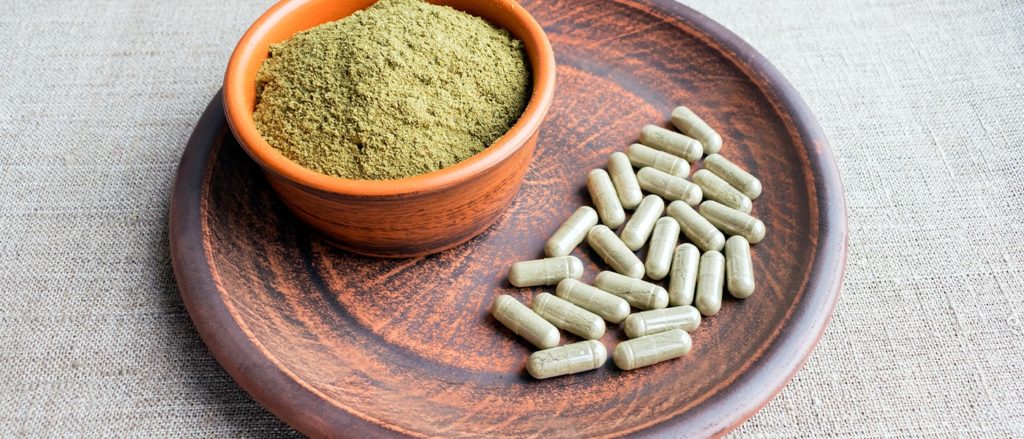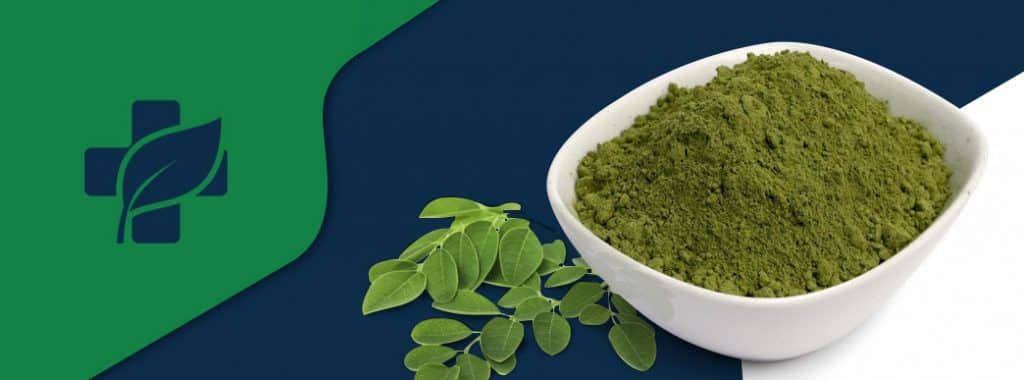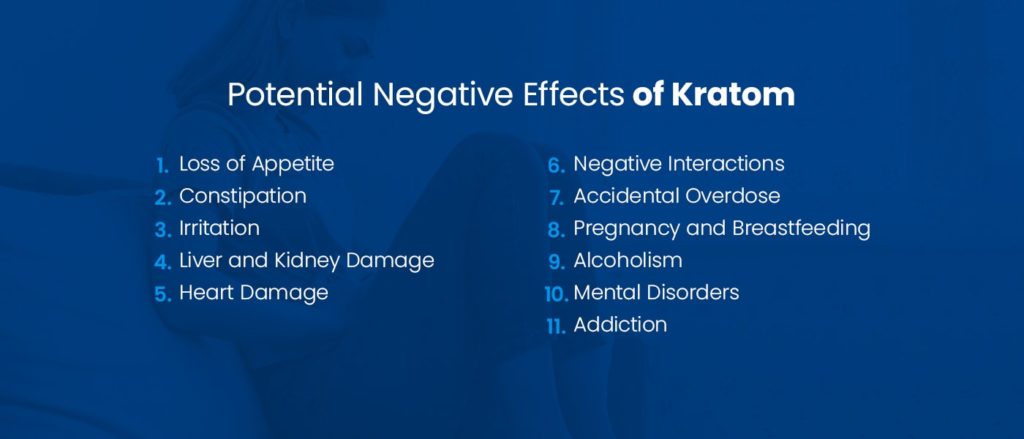
A controversial herbal substance that has the potential to be harmful to unsuspecting users. Is Kratom dangerous, and what are the real risks?
Kratom comes from the leaves of a tropical tree native to Southeast Asia. Most often, kratom is available in leaf and powder form. Also known as Mitragyna speciosa, kratom is a substance that has become increasingly popular over the past decade. Other names for kratom include ketum, biak, thang, kakuam and thom.
Kratom’s popularity has also invited controversy. Many people claim that kratom helps ease the side effects of opioid withdrawal. Yet, the majority of research has reported that it can become addictive when used often. The effects of kratom vary with dosage. That means the way someone may react when taking it can be unpredictable and potentially dangerous. This unpredictability is a major factor in the discussion of is kratom dangerous.
The National Institute on Drug Abuse (NIDA) indicates that kratom can cause “uncomfortable and sometimes dangerous side effects.” They state there is no scientific evidence that kratom is effective or safe for treating addiction. Even after years of this drug circulating, no major drug approval company has cleared it for widespread use. This lack of approval raises serious concerns about is kratom dangerous.
What Is Kratom?

Kratom belongs to the coffee family. After taking small doses, users report feeling talkative, stimulated and alert, like they’ve drank a cup of coffee. Interestingly, a higher dose produces the opposite effect — it can make you feel lethargic and sleepy, similar to an opioid. In both cases, kratom allegedly decreases painful sensations and heightens feelings of pleasure. Due to this discrepancy, experts and researchers remain skeptical of the substance’s reliability. This inherent inconsistency in effects makes many question is kratom dangerous.
People can take Kratom in many ways, usually orally. Some users smoke the substance, while others brew it into tea or put the powder into capsules. After taking the drug, most people start feeling the effects within 10 minutes. These effects can last anywhere from two to five hours.
Although some claim that kratom helps them mentally and physically, the FDA has not approved its use in any form. Meanwhile, the DEA has put the drug on its list of Drugs and Chemicals of Concern. However, many enthusiastic kratom users think it must be safe because it’s a natural plant. While that is a nice sentiment, heroin and cocaine also come from plants as well. Herbs can be medicinal; there’s no doubt about that. Some of them are helpful in curing symptoms, yet plenty of plants we see in nature are poisonous when consumed. Although you likely won’t die from trying kratom once, the risk of adverse effects increases the longer you use it. Currently, there is no known safe amount of kratom for human consumption. This lack of a safe dosage is a primary reason why assessing is kratom dangerous is so critical.
What Is Kratom Used For?
Historically, laborers in Asia used kratom in religious ceremonies or to increase productivity and combat fatigue during long workdays. It is also a remedy for various common ailments or an elixir for social events.
In current times, in the West, people use kratom recreationally. Some look to achieve a “high” or use it in conjunction with prescribed medications. Others use it with medicinal intentions, although there is no evidence that it can provide such benefits.
Some people consider kratom to be helpful in treating their mental illnesses, particularly anxiety and depression. Still, research says the opposite is true, citing an increased risk of suicidal thoughts and behaviors in long-term Kratom users. According to the DEA, consuming kratom can even lead to psychotic symptoms like delusions and hallucinations. These serious potential side effects amplify the question, is kratom dangerous?
When advertised in products, sellers boast kratom’s ability to suppress appetite and aid in weight loss. However, it also comes with side effects like headaches, depression, hallucinations, muscle pain, breathing problems and seizures.
In the past, some research indicated that Kratom could be helpful to people struggling with opioid addiction. Though, that became unreliable when many users reported withdrawal symptoms when trying to cease kratom usage. The emergence of withdrawal symptoms from kratom itself adds to the debate of is kratom dangerous.
Is Kratom Illegal?
While Kratom is not currently illegal federally or in all states, it is illegal in certain places.
As of 2023, kratom is illegal to use, possess or purchase in:
- Alabama
- Indiana
- Rhode Island
- Vermont
- Wisconsin
Kratom is illegal for use in Australia, Malaysia, Indonesia and many European Union countries. Indonesia still participates in the raw export of the product.
The FDA discourages the use of kratom as its production and distribution as a food is not regulated. This means that the quality and safety of kratom, sold anywhere from gas stations to vitamin shops, cannot be guaranteed. The lack of regulation and safety standards is a significant factor in determining is kratom dangerous.
What are the Dangers of Kratom?
Poison control centers have reported an increase in calls due to kratom misuse over the past several years. Many of the effects of kratom are not yet widely known, which could make this drug potentially dangerous. The growing number of poison control calls underscores the urgency of addressing is kratom dangerous.
While overdose is rare, it can become more dangerous when combined with alcohol and other drugs. Despite its “legal” federal status, there still could be potential dangers for users. These potential risks require addressing in regard to kratom and long-term, widespread holistic use.
There is little evidence about the effects of kratom on various body parts, like the kidneys and the heart. Common symptoms of kratom use include increased urination and tachycardia, a condition where your heart beats rapidly. This evidence leads to the belief that kratom has potentially dangerous side effects that span throughout the entire body. The potential for widespread bodily harm reinforces the question, is kratom dangerous.
The medical community is still researching information about any potential benefits of kratom. Currently, health professionals and institutions cannot confidently advise anyone to use kratom but only warn people of possible risks. The medical community’s caution further emphasizes the question of is kratom dangerous.
Negative Side Effects of Kratom

Kratom is a substance that has varying effects on people based primarily on dosage amounts. Usually, when ingested, the effect happens within ten minutes and lasts about 90 minutes on average.
People report that a small kratom dosage provides the effect of alertness and sociability. Meanwhile, larger doses have the opposite effect, causing people to feel slow and heavy. Using kratom regularly could have potential long-term effects that could be unpleasant and potentially life-threatening.
Data research shows both sedative and stimulant dose-dependent effects of kratom do exist, along with:
- Antidepressant activity (improves mood and reduces feelings of sadness or depression)
- Antinociceptive effects (reduces the perception of pain or injury)
- Anorectic effects (reduces appetite)
- Anxiolytic-like effects (relieves anxiety)
There is growing concern regarding the drug’s safety of use. Kratom’s unpredictable effects have garnered national and international attention. The increase in deaths and hospital visits related to extracts of the plant has caused uproar. In many cases, the kratom used was laced or consumed with other illicit substances. This trend of hospital visits and deaths directly addresses the concern of is kratom dangerous.
Some possibly dangerous side effects and adverse effects reported by kratom users are:
Loss of Appetite
Taking kratom regularly could cause significant weight loss. For some, it could lead to eating disorders such as Anorexia Nervosa. With highly restricted calorie intake, the body could experience severe and dangerous weight loss that could negatively affect internal organs. Anorexia can potentially lead to death due to starvation and organ failure and needs medical attention to rehabilitate.
Constipation
With frequent and prolonged kratom use, the bowel and digestive system can begin to slow down. While this isn’t a serious condition, it can become uncomfortable to have infrequent bowel movements that are difficult to pass. In severe cases, this could cause colon issues or even ruptures if no intervention occurs to alleviate the situation.
Irritation
Kratom can cause an inflammatory response leading to facial flushing, making skin appear reddish purple. There have also been bouts of nausea, sweating and frequent itching reported. These effects typically occur upon ingestion of the substance and can sometimes last for hours, causing significant discomfort. Some people will experience such irritation that it can lead to insomnia or disturbed sleep.
Liver and Kidney Damage
When used for a long time in high doses, the liver and kidneys could become significantly damaged by kratom. Instances of very dark urine and yellowing of the skin are signs this kind of damage is taking place. When the liver is compromised, the kidneys take on the task of filtering toxins from the body. They can become overworked, which can lead to kidney failure among people with liver damage.
Heart Damage
Kratom, when taken in higher doses or if mixed with another substance, could increase your heart rate. Also, if you already have a heart condition, you will probably want to avoid using kratom. Talk to your doctor about kratom if you plan on experimenting with the herb. It has shown the potential to worsen already existing heart conditions.
Negative Interactions
Mixing kratom with other drugs can cause potentially hazardous side effects. Mixing this drug with psychoactive substances creates an adverse drug interaction that can lead to potential seizures. When taken with opioids, each drug may intensify the effects of the other, causing a potentially life-threatening overdose. Between 2010 and 2018, the number of calls to U.S. poison control centers has skyrocketed and confirmed overdose deaths.
Accidental Overdose
People who already have a high opioid tolerance who take kratom run the risk of overdose. Their dependence on opioids could cause them to dose kratom improperly. Those who buy powdered kratom have no way of verifying whether the substance was laced with other drugs to exaggerate effects. In any case, kratom causes respiratory depression, which could enhance and quicken a fatal overdose.
Pregnancy and Breastfeeding
There isn’t enough credible data and information surrounding the use of kratom during pregnancy or while breastfeeding. Everything a pregnant mother ingests passes to the fetus through the bloodstream. Therefore, you should probably avoid using it altogether to stay on the safe side.
Alcoholism
Kratom and alcohol, when used together, can have serious consequences. Research indicates that individuals who struggle with alcohol dependence and also use kratom may face an increased risk of harm to their well-being, including a heightened risk of suicide. This risk is notably higher compared to those who use kratom without alcohol dependence.
Mental Disorders
Kratom could potentially make mental disorders worse. Those who already have a mental disorder and are using the herb seem to have a higher risk of suicide. When compared to those using the herb without a mental disorder, kratom users with mental illness are at higher risk. This phenomenon is also currently developing with legalized recreational marijuana.
Addiction
Long-term use of kratom could potentially lead to developing an addiction and dependence on the drug. Certain chemicals in kratom activate the brain’s opiate signaling. When this occurs, it can help regulate the withdrawal symptoms that opioid drug addiction can cause. However, this does suggest kratom can also be addictive because of these psychotropic and mind-altering compounds.
Just like all drugs, people can become addicted to the effects of kratom. This is probably the most dangerous long-term effect of this drug, as physical dependence can occur with time. As with all dependence, people who stop using kratom could experience uncomfortable withdrawals that include:
- Aches
- Pain
- Nausea
- Vomiting
- Diarrhea
- Aggression
- Insomnia
- Anxiety
- Agitation
- Other symptoms
Tolerance
Long-term kratom users could develop a tolerance to the drug, requiring progressively bigger doses to feel the same effects. Some may even begin developing compulsive drug-seeking behavior. This can cause them to use the drug despite any harmful effects or negative life consequences because of their addiction.
In one study researching kratom as a potential treatment for opioid withdrawal symptoms, individuals took the drug for over six months. They reported experiencing similar withdrawal symptoms as those following opioid use.
More than 50% of the regular users who used the drug for more than six months developed severe kratom dependence. The other 45% displayed moderate kratom dependence. Individuals experienced physical withdrawal symptoms such as:
- Pain and muscle spasms
- Watery nose/eyes
- Sleeping difficulty
- Decreased appetite
- Fever
- Hot flashes
- Kratom diarrhea isn’t uncommon either, and doctors receive reports of tremors, delusions and other more serious issues.
Also, psychological withdrawal symptoms could include:
Anger
- Restlessness
- Nervousness
- Sadness
The long list of potential side effects compels us to ask repeatedly, is kratom dangerous. The risks are significant.
Treatment for Kratom Misuse or Addiction
Many illegitimate claims exist on the internet from websites selling kratom. They claim that it can be used as a means to decrease opioid dependency during detox. Science has not substantiated any of these claims. This means that kratom can be a dangerous and potentially harmful substance. People who started using kratom to help their opioid addiction only found themselves becoming addicted to kratom. Experts suggest not using kratom as a substitute for proper addiction treatment, especially with opioid addiction. The fact that addiction to kratom itself is a risk confirms that is kratom dangerous is a well-founded concern.
Some may find themselves dealing with a kratom addiction. Whether they began using it to lessen their opioid misuse or by other means, the risk exists. The fact that there isn’t much-researched information on the substance can make this a frightening experience. The best treatment process for kratom addiction is similar to other drug treatments — overseen by a medical professional.
You might prefer detoxing from kratom at a professional facility where trained staff monitors and provides you with medical treatment. Some withdrawal symptoms, like increased blood pressure, could pose a medical risk. A professional detox facility could make you more comfortable and increase your chances of complete recovery.
Learn More About Kratom and Ask Questions
The National Institute on Drug Abuse would like you to remember these main points about kratom:
- Mitragynine and 7-α-hydroxy mitragynine are the two compounds in the leaves of kratom.
- They interact with the brain’s opioid receptors and produce pleasure, sedation and decreased pain.
- Mitragynine may also interact with your brain’s other receptor systems, producing stimulant effects.
- Kratom’s reported health effects include sweating, nausea, psychotic symptoms and seizures.
- Some users become addicted to the drug.
- Commercial forms of kratom may be laced with other substances that have led to deaths.
- There are no current medications or behavioral therapies explicitly tested for kratom addiction treatment. But does kratom have value as a medicine? The NIDA’s cautions are a stark reminder of the importance of understanding if kratom is dangerous.
Contact AppleGate Recovery Treatment Centers for Help
If you are struggling with kratom and opioid addiction, contact us and let us help you get your life back. AppleGate Recovery offers outpatient medicine-assisted treatment for opioid and kratom addiction with buprenorphine or methadone.
Kratom is not a substance or method approved or supplied at any AppleGate Recovery centers. Those addicted to kratom receive the same treatment as those with other addictions.
We also provide case management, community resource referrals, substance abuse counseling and other supportive services to support our evidence-based treatment and help you reclaim your life. Give us a call or send us a message and get started today.
The question of is kratom dangerous is not easily answered with a simple yes or no. The substance presents a complex profile of potential benefits and significant risks. The lack of regulatory oversight, the variability in its effects, and the potential for addiction and severe side effects all contribute to the ongoing debate. The growing body of evidence highlighting adverse effects and the increasing number of calls to poison control centers underscore the need for caution.
For those considering kratom use, understanding the potential dangers is crucial. The lack of long-term studies and the unpredictability of its effects make it a substance that should be approached with extreme caution. Ultimately, the decision to use kratom should be made with a full understanding of the risks involved, and ideally, in consultation with a healthcare professional.
For those struggling with kratom addiction, seeking professional treatment is important. Recognizing the potential harms and addressing the question of is kratom dangerous requires ongoing research and informed decision-making.
People Also Read:

Contact AppleGate Recovery Today
If opioid addiction is impacting your life or the life of someone you care about, reach out to our treatment center. We are here to provide the support and care you need to take the first step toward recovery.
Call 888.488.5337

